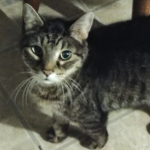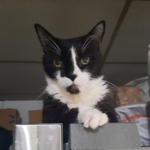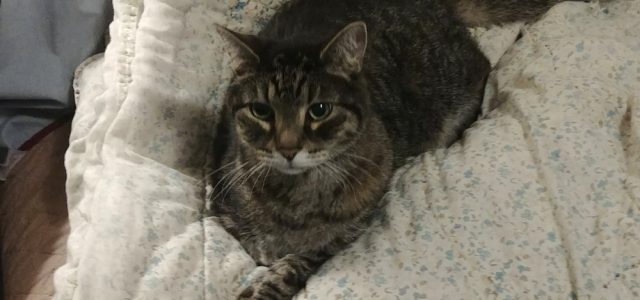 Feline diabetes is a condition that requires diligent management to ensure a cat’s health and well-being. When our cat Zipper first was diagnosed with Feline Diabetes, there were two primary approaches to regulating his blood glucose level: loose regulation and tight regulation. Loose regulation involves administering a fixed insulin dose determined by the veterinarian based on a glucose curve taken at a single visit. In contrast, tight regulation requires daily glucose testing by the owner and adjusting insulin dosage based on real-time readings.
Feline diabetes is a condition that requires diligent management to ensure a cat’s health and well-being. When our cat Zipper first was diagnosed with Feline Diabetes, there were two primary approaches to regulating his blood glucose level: loose regulation and tight regulation. Loose regulation involves administering a fixed insulin dose determined by the veterinarian based on a glucose curve taken at a single visit. In contrast, tight regulation requires daily glucose testing by the owner and adjusting insulin dosage based on real-time readings.
 While loose regulation may be more convenient for busy pet owners, we thought tighter regulation offered more precise control over the cat’s diabetes and can even lead to remission in some cases. We’ll compare these two approaches, outlining their advantages and disadvantages, and ultimately argue that tight regulation is the superior method based on our experience with Zippy and now Bentley.
While loose regulation may be more convenient for busy pet owners, we thought tighter regulation offered more precise control over the cat’s diabetes and can even lead to remission in some cases. We’ll compare these two approaches, outlining their advantages and disadvantages, and ultimately argue that tight regulation is the superior method based on our experience with Zippy and now Bentley.
Loose Regulation: Convenience Over Precision
Loose regulation is the most commonly recommended method by veterinarians, primarily because it requires less daily effort from the pet owner. In this approach, the cat undergoes a glucose curve at the vet’s office, where blood sugar levels are tested periodically over a day. Based on these readings, the veterinarian prescribes a fixed insulin dose that the owner administers consistently at home, typically twice daily.
Pros of Loose Regulation
- Ease of Use – Owners simply follow a fixed schedule without the need for daily glucose monitoring.
- Less Stress on the Cat – Many cats dislike being handled for blood glucose testing, making this method more tolerable for both the pet and the owner.
- Veterinary Oversight – The initial dosage determination is handled by a professional, reducing the owner’s burden of decision-making.
Cons of Loose Regulation
- Potential for Fluctuations – Blood sugar levels in cats can vary significantly based on diet, stress, illness, and other factors. A single glucose curve may not capture these fluctuations accurately.
- Risk of Hypoglycemia or Hyperglycemia – Without daily monitoring, there is a higher risk of over- or under-dosing insulin, which can be dangerous.
- Lower Likelihood of Remission – Cats on a fixed-dose regimen may not receive the optimal level of insulin required to push them into remission.
Loose regulation is often the default recommendation from veterinarians, particularly for owners who lack the time or resources for daily testing. However, this method leaves room for variability in the cat’s blood glucose levels, which can impact long-term health.
Tight Regulation: A More Controlled Approach
Tight regulation requires the owner to test the cat’s blood glucose levels daily, typically before administering each insulin dose. This approach allows insulin dosages to be adjusted based on the cat’s current glucose level, providing a more responsive and individualized treatment plan.
Pros of Tight Regulation
- Better Glucose Control – Adjusting insulin based on real-time readings ensures that the cat receives the appropriate amount of insulin at each dose.
- Higher Remission Rates – Many cats achieve diabetic remission (where they no longer need insulin) when their glucose is tightly controlled.
- Early Detection of Issues – Daily monitoring allows owners to spot potential complications, such as infections or changes in insulin sensitivity, before they become severe.
Cons of Tight Regulation
- Time-Consuming – Owners must commit to daily blood glucose testing, which requires time and effort.
- Learning Curve – Testing blood glucose and adjusting insulin requires some knowledge and experience, which can be overwhelming at first.
- Stress on the Cat and Owner – Some cats resist testing, making the process stressful for both the animal and the owner.
While tight regulation requires more effort, its benefits are substantial. Cats managed with this method have a better chance of maintaining stable glucose levels and even achieving remission, making it the preferred approach for those who can manage it.
The Case for Tight Regulation
Given the advantages and disadvantages of both methods, tight regulation emerges as the superior choice for managing feline diabetes—provided the owner can dedicate the necessary time and effort. The key benefits of tight regulation, including precise glucose control, reduced risk of complications, and a higher chance of remission, make it a compelling option. However, it is understandable that some owners may not have the ability to commit to daily testing, in which case loose regulation serves as a viable, albeit less optimal, alternative.
Veterinarians often recommend loose regulation because it is easier for most pet owners to follow. However, if an owner has the time and willingness to engage in tighter regulation, it can significantly improve their cat’s quality of life. The decision ultimately depends on the owner’s ability to integrate daily glucose testing into their routine and the cat’s tolerance for regular monitoring.
Zipper’s Remission
When Zipper was first diagnosed with Feline Diabetes, we were scared. The diagnosis itself was like a bomb dropping and then your mind automatically goes to humans monitoring their own glucose levels for insulin shots and you just automatically panic thinking about how you will manage your own cat’s Diabetes knowing you have their life in your hands if it goes wrong somehow. We had the choice of loose regulation and tighter regulation.
We chose tighter regulation and did our research on making it as easy as possible for Zippy and ourselves. We couldn’t be more happy about our decision. After about a year and a half of Zippy on tighter regulation he did indeed go into remission for the disease. We continued testing him periodically but his Diabetes never came back and his glucose level remained normal the rest of his life. We cn only hope we get the same result with Bentley.
Conclusion
Managing feline diabetes is a commitment, and choosing the right approach can greatly impact a cat’s health. Loose regulation provides a simpler, less time-intensive method but carries the risk of glucose fluctuations and lower remission rates. Tight regulation, while more demanding, offers better glucose control and a higher likelihood of remission. For cat owners who can accommodate daily testing, tight regulation is our recommended approach.
However, for those who cannot, loose regulation remains an acceptable alternative. The goal is always to provide the best possible care for the cat, balancing the owner’s ability to manage the condition with the cat’s health needs. By understanding the differences between these two approaches, owners can make informed decisions to ensure their feline companions live long, healthy lives despite their diabetes diagnosis.




